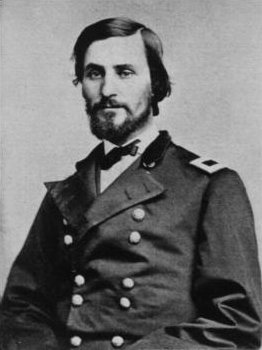William Sooy Smith facts for kids
Quick facts for kids
William Sooy Smith
|
|
|---|---|

William Sooy Smith
|
|
| Born | July 22, 1830 Tarlton, Ohio |
| Died | March 4, 1916 (aged 85) Medford, Oregon |
| Place of burial | |
| Allegiance | United States of America Union |
| Service/ |
United States Army Union Army |
| Years of service | 1853–1854; 1861–1864 |
| Rank | |
| Commands held | 13th Ohio Infantry Regiment 1st Division / XVI Corps Cavalry / Mil. Div. of the Mississippi |
| Battles/wars | American Civil War |
William Sooy Smith was an important American engineer and a brave soldier. He was born on July 22, 1830, and passed away on March 4, 1916. He went to the famous West Point military school. Later, he became a civil engineer, which means he designed and built things like bridges. During the American Civil War, he served as a brigadier general in the Union Army.
Outside of the army, he was very famous for building bridges. He even helped build the world's first big bridge made entirely of steel!
Early Life and Engineering Career
William Sooy Smith was born in Tarlton, Ohio. He studied engineering at Ohio University and graduated in 1849. He then continued his studies at West Point, a top military academy. He finished sixth in his class in 1853.
After graduating, Smith worked for the Army for a short time. He then left in 1854 to work for the Illinois Central Railroad. In 1857, he started his own engineering company called Parkinson & Smith. One of his first big projects was surveying for a bridge that would connect the United States and Canada across the Niagara River.
Serving in the Civil War
When the Civil War began in 1861, William Sooy Smith joined the Union Army. He became a colonel of the 13th Ohio Infantry regiment. He fought in western Virginia before being promoted to brigadier general in April 1862.
General Smith took part in the important Vicksburg Campaign. During this time, he led the first division of the XVI Corps. In January 1864, he was given command of a large cavalry force. His mission was to support General Sherman's attack on Meridian, Mississippi.
However, Smith's forces were defeated by Confederate troops led by Major General Nathan Bedford Forrest in the Battle of Okolona. Smith had to retreat into Tennessee. He was criticized for this, as it put General Sherman's plan in danger.
After this, he became the chief of cavalry for important military departments. He served under famous generals like Ulysses S. Grant and William T. Sherman. In July 1864, he had to leave the army because of a health problem called rheumatoid arthritis.
Life After the War
After the war, Smith went back to his work as a civil engineer. In 1867, he used a new method called a pneumatic caisson to build the Waugoshanee lighthouse. A caisson is a special watertight box used for construction underwater.
From 1878 to 1879, Smith worked on the Glasgow Railroad Bridge in Glasgow, Missouri. This bridge was very special because it was the first large bridge in the world made entirely of steel!
In 1876, William Sooy Smith won an award at the American Centennial Exposition for his engineering work. He continued to work as an engineer until he retired to Medford, Oregon. He passed away in 1916 and was buried in Forest Home Cemetery in Forest Park, Illinois.


